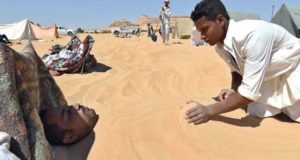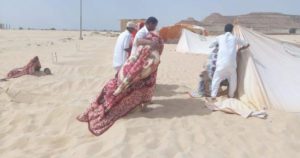Sand Burial, local name “Mardam”
It is used for curing and pain relief for many complains such as Rheumatism, Rheumatoid arthritis, Back pain, Skin diseases, Joint stiffness, Hemorrhoids, Disc, and Prostate and Liver diseases.
The curer decided on the duration needed for therapy, which is always counted in odd numbers (3, 5, 7 days) with minimum of three, and might extent to one month depending on the case.
Early in the morning, three or four people start digging the hole in the sand to allow it collect as much sun and heat as possible. The hole is not very deep, but enough for a whole person to lay in it. By mid-afternoon, the patient would be escorted to the mardam (burial site), given that he was prevented from eating three hours earlier. He or she would lay in the hole naked, and his/her body would be totally covered with sand expect for the head. An umbrella or a blanket supported with sticks would be used to provide shade to the head. Duration in the sand would be between fifteen to forty five minutes according to his/her tolerance. The curer would perform Tarbeet, which is basically pressing on the patients’ limbs, and halfway through the burial, the batch of sand would be exchanged with fresh hot one.
When the patient comes out of the sand, he/she is wrapped in a blanket and escorted to a tent that was set nearby; he/she is left to rest inside, again lying on the hot sand. Certain hot drinks are provided which will encourage the body to produce more sweat. These drinks are Helba (Fenugreek), Karkade (Roselle), Yansun (Anise), and Ne’na’ (Mint). The patient could stay in the air tight tent up to two hours, with a minimum of twenty minutes. Afterwards, he/she would dress, preferably in cotton clothes, and then be escorted back to the room where he would be served hot soup and lemonade.
All through the curing duration, and for another three days afterwards, the patient is not allowed to drink cold beverages, bath, or be subjected to breeze. By the end, he/she would be massaged with olive oil, salt, and vinegar to close the skin pores.
This remedy only takes place in summer, and might extend to early autumn if the weather is still hot.




